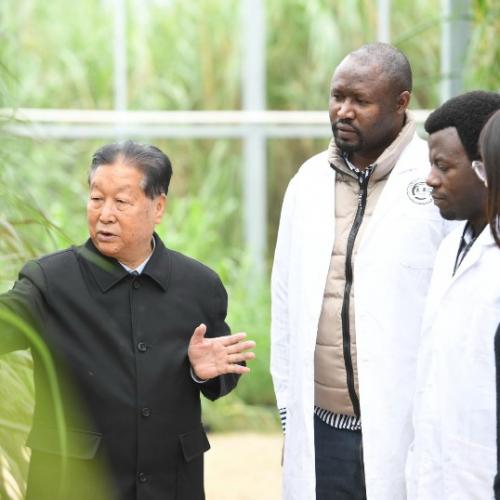


Editor's Note: The eyes of the world are turning to China. In this ongoing series How-to China, we tell stories about how Chinese approaches promote understanding, solve problems and improve the lives of people around the globe.

A type of grass in China is making waves in recent years. It can be chopped and used as a substrate for growing edible and medicinal fungi; it is good feed for livestock; it also blocks harsh desert winds. This multipurpose plant is called Juncao, or "mushroom grass".
The Juncao technique was introduced for the sake of poverty alleviation and has turned out to be quite a success.
According to Lin Zhanxi, chief scientist at the China National Engineering Research Center of Juncao Technology, the technique has been promoted in 106 other countries.
Local farmers' incomes have doubled, even tripled, after they grew mushroom with Juncao. Some tribes in Papua New Guinea have even stopped fighting ever since the technique was introduced and helped solve their grain shortage problem.
In an exclusive interview with China Daily, Lin shares his experience with the magic grass.
Watch video: Magic grass spreads prosperity and peace overseas
Following are excerpts from the interview:

Q: How did you invent the Juncao technology? What's the hardest part?
Lin: The Juncao technique was developed in China as part of an experiment to help people overcome poverty.
In the 1970s, China introduced a mushroom cultivation technique that uses timber as substrate to help impoverished farmers in mountainous regions. But this method led to deforestation. To address the problem, we needed to find an alternative breeding technology.
We encountered many difficulties during the research process. The most difficult part was that we didn't have past experience to learn from.
We experimented with many types of grass to see which one could be used to grow mushrooms, how to process the grass, and how to grow mushrooms with the grass.
After three years of hard work, we succeeded in growing mushrooms with grass instead of trees. This is the Juncao technique.

Q: Could you tell us a little bit about some difficulties you faced while promoting this technique in Papua New Guinea 20 years ago? How did you overcome these difficulties?
The biggest obstacle we faced was when we were teaching this technique to locals in the Eastern Highlands (Papua New Guinea).
We kept simplifying the technique to make it easier for the locals to pick it up.
I have a picture here.

It's a sterilization device made from three petrol cans. It can match the sterilization efficiency of an oil-fired boiler, but costs just 800 yuan ($125), as compared to traditional sterilization methods that cost more than 100,000 yuan.
It is also safer. There is no need to train locals to handle boilers, which is a highly professional skill set.
Besides, it is portable and can be moved from one village to another once the work is done.
We also taught the breeding technique to locals on site, which has achieved good results after nearly 20 years of efforts.

Q: Are there any moments from the whole process that you still recall?
Lin: In a village called Finitugu (Eastern Highlands), different tribes often fought with each other.
After we taught them to grow mushrooms with Juncao and also to grow rice in arid land, it solved their grain shortage problem and their incomes increased.
After that, they signed peace agreements to stop fighting among themselves and passed on 1.2 metric tons of rice seeds to our team, asking us to donate these to poorer farmers.

They also invited the governor of the Eastern Highlands to attend a ceremony and inscribed the name of our project and the names of the project managers on a stele.
Our experience in the past decades is that Juncao is not only good for pulling local residents out of poverty, but also improves the ecological environment.
We will let more people in developing countries benefit from the use of this technique.

Q: What are some of the ways in which this method of cultivation raises people's incomes and quality of life?
Lin: In the Eastern Highlands alone, growing Juncao, mushrooms and rice on arid land helped more than 5,200 farmer households to double their incomes.
At a demonstration base in Rwanda, we combined ecological treatment of the river water, water loss and land erosion and the Juncao industry. It helped 3,000 farmer households to double, or even triple, their incomes.
An estimated more than 500,000 people are attached to the Juncao industry. In the future, tens of millions of people may participate in it.

Q: Can you tell us how you spread the technology in these countries? How many Chinese people were involved in its overseas promotion over the years? Please name the countries.
We have sent more than 40 expert groups to promote Juncao technology overseas. Sometimes, a group had three or four people, and sometimes a dozen.
We selected some regions or countries to launch pilot projects.
For example, Fiji is one of the demonstration bases in the South Pacific region.
Papua New Guinea is an island country with which we joined hands to implement the UN 2030 Sustainable Development Agenda. Rwanda is the example of an inland African country where we promoted Juncao.
We have set up flagship demonstration projects in five countries.
And demonstrations bases have been established in a total of 16 countries, including Madagascar and Malaysia.
Right now we have kept in touch with and promoted the Juncao technique in 106 countries.

Q: Promotion of this technique is part of the Belt and Road Initiative. In recent years, some countries have labeled it as "debt-trap diplomacy". Since you have firsthand experience under the initiative, do the accusations make sense?
Lin: There was never any debt trapping or conspiracy.
We just wanted to help local people increase their incomes, improve the ecological environment there and help people live better lives.
Local people welcomed us and local governments were also very supportive.
About the interviewee

Dubbed "father of the Juncao grass", Lin Zhanxi is the chief scientist at the China National Engineering Research Center of Juncao Technology. Lin invented the Juncao technology in 1986.
The technology has been promoted to 106 countries across the world. The technology won the Geneva State Prize at the 20th International Invention Exhibition in 1992.
In 1994, the technology was listed by the United Nations Development Program as one of China's priority projects for cooperation with other developing countries.
Reporters: Ian Goodrum, Hu Meidong, Jiang Wei, Chen Ziyan and Ma Chi
Editors: Shan Juan and Wang Jianfen
If you have any problems with this article, please contact us at app@chinadaily.com.cn and we'll immediately get back to you.